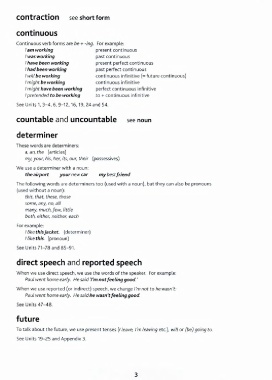Page 394 - murphy_raymond_english_grammar_in_use 1
P. 394
contraction see short form
I a m w o rk in g present continuous
I w a s w o rk in g past continuous
I h a v e b e e n w o rk in g present perfect continuous
I h a d b e e n w o rk in g past perfect continuous
I will b e w o rk in g continuous infinitive (= future continuous)
I might b e w o rk in g continuous infinitive
I might h a v e b e e n w o rk in g perfect continuous infinitive
I pretended to b e w o rk in g to + continuous infinitive
See Units 1, 3-4, 6, 9-12,16,19, 24 and 54.
countable and uncountable see noun
determiner
These words are determiners:
a, an, the (articles)
my, your, his, her, its, our, their (possess!ves)
We use a determiner with a noun:
th e a ir p o r t y o u r new c a r m y best frie n d
The following words are determiners too (used with a noun), but they can also be pronouns
(used without a noun):
this, that, these, those
some, any, no, all
many, much, few, little
both, either, neither, each
For example:
I like th is ja c k e t (determiner)
I like th is, (pronoun)
See Units 71-78 and 85-91.
direct speech and reported speech
When we use direct speech, we use the words of the speaker. For example:
Paul went home early. He said I'm n o t fe e lin g g o o d .'
When we use reported (or indirect) speech, we change I'm not to he wasn't:
Paul went home early. He said h e w a s n 't fe e lin g g o o d .
See Units 47-48.
future
To talk about the future, we use present tenses (/ leave, I'm leaving etc.), will or (be) going to.
See Units 19-25 and Appendix 3.
3

